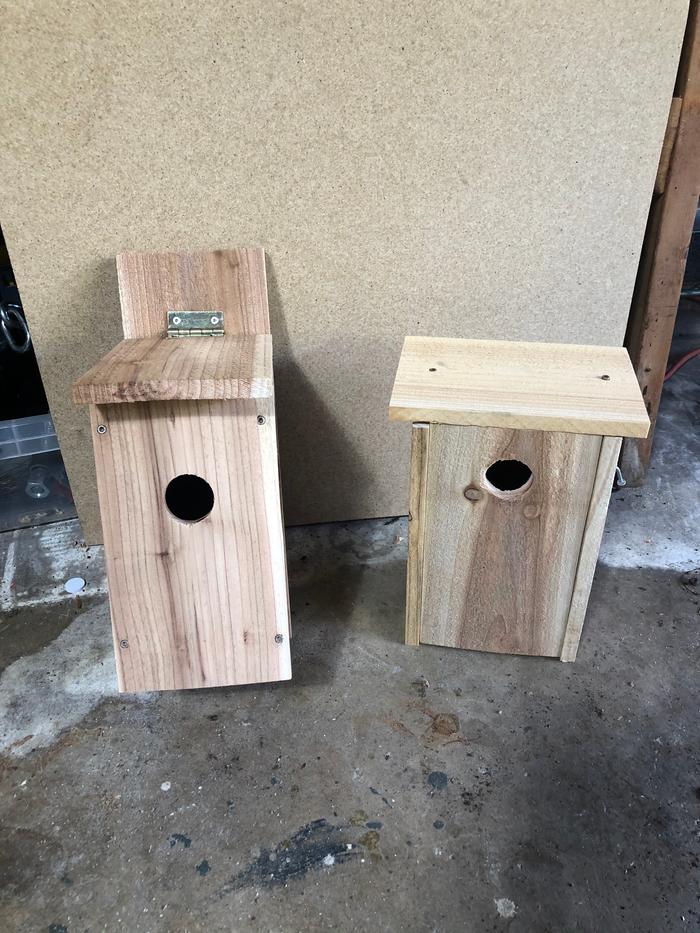I am submitting birdhouses but went about it a little differently. First I had a short list of birds I wanted to provide for. I wanted to provide nest platforms for:
American robin / mourning dove
Carolina chickadee / tufted titmouse
Carolina wren
American kestrel/yellow-shafted flicker/Eastern screech
owl
I also wanted to know about placement for occupancy success, etc. So I went to Cornell's NestWatch in order to look at specific designs. You can find them here:
https://nestwatch.org/learn/all-about-birdhouses/right-bird-right-house/
I supplemented the American kestrel/yellow-shafted flicker/Eastern screech owl research by looking at the boxes used by going to the Northeast Connecticut Kestrel Project and looking at the plans by Art Gingert. Find them here:
http://nectkestrels.com/websites.htm
Additionally, I looked at the Hawk Mountain Sanctuary page for info (NOTE: the box plans are at the bottom of the page):
https://www.hawkmountain.org/conservation-science/active-research/raptor-conservation-studies/american-kestrels
I had a number of questions and started by talking to Art a few times via phone. He led me to Bob DeCandido of the American Kestrel Nest Survey NYC project. That info can be found here:
http://www.battaly.com/nehw/AmericanKestrel/news/
To look at appropriateness I also looked at flicker and screech owl boxes:
https://wdfw.wa.gov/sites/default/files/2019-11/flicker_nestbox.pdf
http://www.americanartifacts.com/smma/per/nestcam/10flicker.htm
https://www.audubon.org/news/how-build-screech-owl-nest-box
http://www.lakesidenaturecenter.org/MDC%20Plan%20-%20Sparrow%20Hawk%20or%20Screech%20Owl.pdf
https://news.maryland.gov/dnr/2020/01/01/habitat-project-eastern-screech-owl-boxes/
https://www.tn.gov/twra/wildlife/woodworking-for-wildlife/eastern-screech-owl-nest-box.html
Then I saw a YouTube video of a near instant predation event by a red-tailed hawk on a screech owl sitting inside a nest box with camera. That caused me to reach out to several DNR folks and box makers. To a person they said the box on the video and several sites are too shallow once you look at hole size, placement of hole and the boxes being shallow in general. That led me to make deeper boxes. I also had to modify designs to have the front open for cleaning rather than a side. This was due to the fact that I'd be standing on the 2nd floor roof to service and given how they would be mounted, side-opening would be less desirable.
I waiting for a long time for the right wood as the larger boxes needed larger pieces of wood. Then a friend asked me if I wanted shelves he ripped out of a house. There was enough poplar, maple, and fir that I now had enough to proceed.
I looked at platform-type next boxes for mourning doves and robins. I looked at Cornell again and sites like:
https://journeynorth.org/tm/robin/NestBox.html
https://70birds.com/bird-species/mourning-dove/
I modified to fit the constraints of the wood I had and the sites they would be located.
Finally, I'd already made some wren boxes and used sites like:
https://70birds.com/bird-species/wrens/
http://www.nestboxbuilder.com/nestbox-plans.html
I was able to use the scrap from the large boxes to cobble most of the wren and robin box parts.
I was lucky enough to use the shop of a friend and got to use a number of tools I don't have and procedures for angling cuts and whatnot. This was being planned for years but only recently was it a possibility as I wanted to scrounge the wood that might otherwise be wasted. One of the shelves had a dark stain covering. The shelves were 30-35 years old. I took the stain off of what would become the insides of the boxes. I was able to make two boxes with the stained pieces.
The large boxes had grooves cut into the front and two sides for chick ladders and chick perches below the holes in order to make exiting or hanging out near the hole easier. I sanded the sides, tops, backs, and bottoms glass-smooth so as to shed water more quickly. I added drainage to the bottoms of each box.
I did not want to use cedar as there are now warnings about compounds in the wood creating respiratory issues for nestlings and adults when using cedar for birdhouses.
All boxes were put together with screws so that I could easily replace damaged or rotted panels when necessary. I hate doing stuff over when a little planning on the front end can save materials or make them last longer. Especially since scrounged lumber comes rarely in my area. Additionally, to make the wood last longer I used beeswax on all seams, knotholes, dents, and anywhere that might create water issues. I used a mix of a few drops of orange oil and beeswax to treat any end grain. The oil was to help soak into endgrain tissue. This should keep the boxes functional far longer and hopefully will cut back on future maintenance. It also allowed me to leave the interior free of anything except for unfinished surface.
All boxes have been weathered for a year and have been installed. The weathering helps with roughening the inside but not with the same potential for splinters entering tender chick skin that physical or rough wood might take.
I know the bb was for the construction of 5 minute bird houses but I wanted to target certain species and make them appropriate for that narrow range of occupants. Additionally, I didn't want design to get in the way of occupancy. There are a lot of commercial birdhouses that are ill-suited for occupancy even by the least choosy species.
For those who hung in through the nerdy stuff, here are the photos...

 3
3




 1
1




 1
1















 6
6
























 2
2













 3
3




 3
3










 3
3





 3
3














